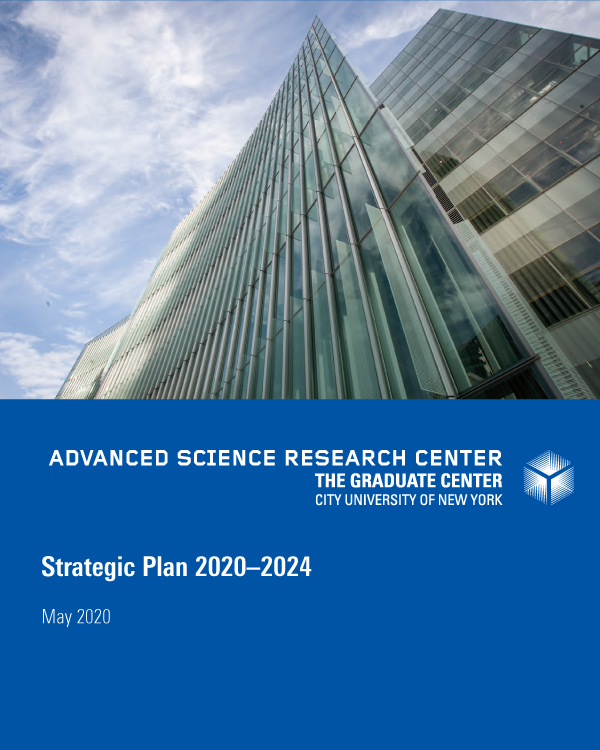
We will create opportunities to expand the ASRC’s funding base from traditional grant funding; develop strategies to gain philanthropic and foundation support; and explore innovative working models for university–private sector collaborations, capitalizing on the center’s cutting-edge research facilities and unique workforce training opportunities.
Financial support for the ASRC comes from multiple sources, including: tax levy funds, capital funds from the Dormitory Authority of the State of New York (DASNY), and external research grants from federal and nonfederal sources, which are administered through the Research Foundation of The City University of New York and provide indirect cost recovery. The ASRC also generates revenue from its core facilities. In its first five years of operation, sponsored program and core facility revenue increased by an average of 60% annually, and the center has been sufficiently funded to meet its needs and to jump-start a successful, world-recognized research program.
Objectives
To succeed in the aspirational growth of its scientific and educational programs and maintain its position at the cutting edge of technology, the ASRC must continue to broaden and increase its revenue from multiple sources, including:
- Federal and nonfederal funding agencies
- Academic, industry, and nonprofit research partnerships
- Philanthropic organizations and donors
- Core facility usage
The expenses related to the interdisciplinary and high-risk research we envision coming from the ASRC and its cross-campus centers of excellence as well as the cost of continuing to equip and maintain the core facilities with state-of-the-art instrumentation will require significant investments unlikely to come from traditional grant mechanisms.


Implementation Plan
To ensure the ASRC’s financial stability during the next five years and beyond, we will pursue three major strategies:
It will be crucial to increase revenues from external research grants by attracting larger funds from a more diverse pool of funding agencies. The discussion earlier of the need to cultivate strategic partnerships is particularly relevant here, that is, to actively seek multi-university, multi-PI, interdisciplinary, large funding opportunities. These opportunities exist through the Department of Defense Multidisciplinary University Research Initiatives, National Institutes of Health, National Science Foundation Engineering Research Centers and Science and Technology Centers, and Defense Advanced Research Projects Agency, which together are likely to provide key support to bolster research revenues above and beyond smaller federal and non-federal funding mechanisms that will still be pursued by individual investigators. Also of note, the National Science Foundation’s funding opportunities for convergence research are also in line with the goals of the ASRC’s interdisciplinary approaches.
These large awards will increase the visibility of the ASRC among scientists nationally and internationally. They will also boost indirect cost recovery, which is another important source of revenue for the ASRC to cover some of its facilities and administrative expenses. It should be noted that running such centers successfully requires an extensive and efficient administrative support structure, both during the preparation of proposals and execution of these centers.
While funding from federal and nonfederal agencies will remain an integral component of the research support for the ASRC, these sources traditionally recognize excellence in specific disciplines, and outside of a few mechanisms, such as the National Research Foundation’s convergence research initiatives, it is difficult to obtain funds to spur new high-risk ideas and interdisciplinary concepts.
Fundraising through philanthropy will give ASRC scientists the flexibility to pursue new areas of research, expand their expertise, and attract talent. Philanthropic support can be used to spur innovative preliminary studies and proposals and support students and researchers seeking training in interdisciplinary science. We will hire a development officer focused on philanthropic fundraising efforts that allow ASRC scientists to pursue breakthrough research and address the most challenging questions of our day.
Outreach efforts to enhance the user base of the ASRC’s core facilities are needed to reach the goal of covering the major portion of core facility expenses and equipment updates and achieve a financial steady state. The variety of funding streams for core facilities (Research Foundation of CUNY, Graduate Center auxiliary accounts, and tax levy funds) require an improved process for financial tracking and reporting. Clearer financial reporting must be achieved in order to identify a more targeted user base for the core facilities.
Better connections with local industrial and extramural academic scientists will be crucial, and recent efforts to streamline the process of establishing agreements and contracts with external researchers has been helpful.
There are also opportunities for the ASRC to serve the research needs of municipal and state agencies, such as the departments of health, transportation, and environmental protection. In addition, core facilities and their directors should undergo regular reviews to assess progress and establish short- and long-term goals with ASRC leadership. A better connection with the venture capital community in the New York metropolitan area will also be critical. Enhancing ASRC interactions with venture capital funds and private equity firms on issues like technology and intellectual property validation could provide another important and steady source of funding.
We want to hear from you!
Send us your comments or questions on the 2020-2024 Strategic Plan.

